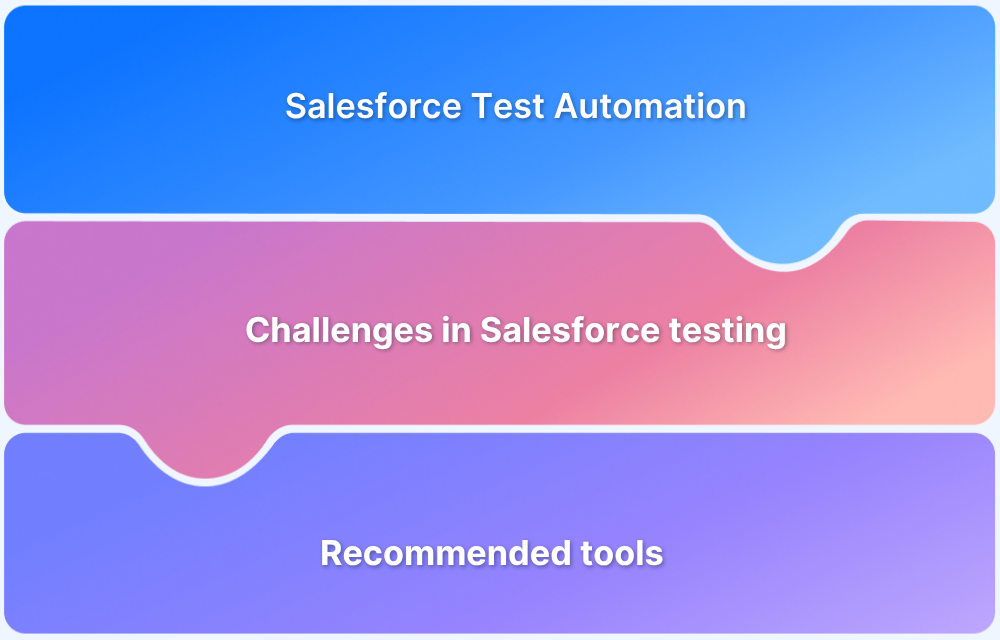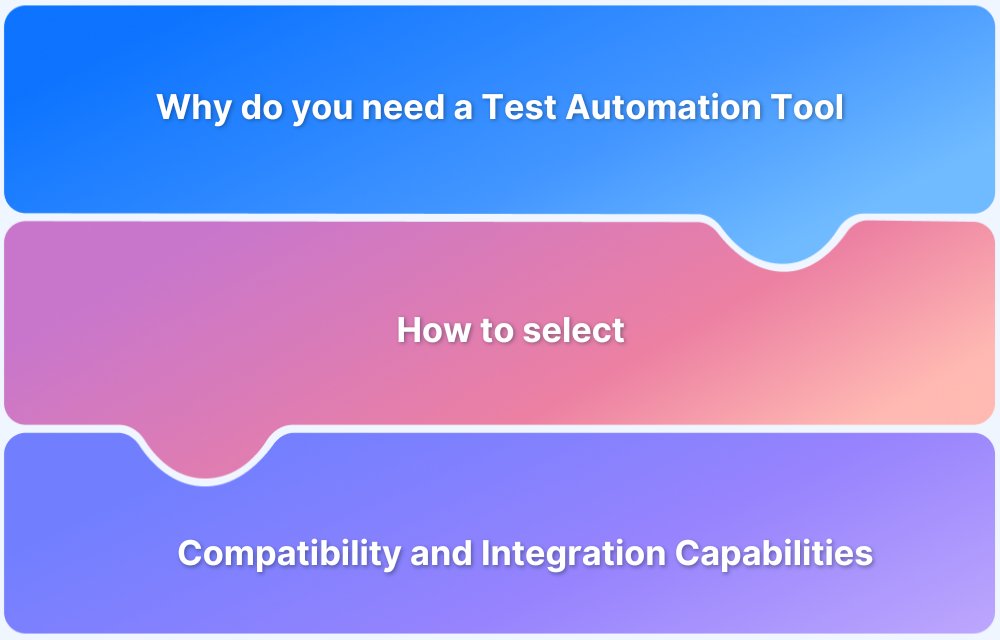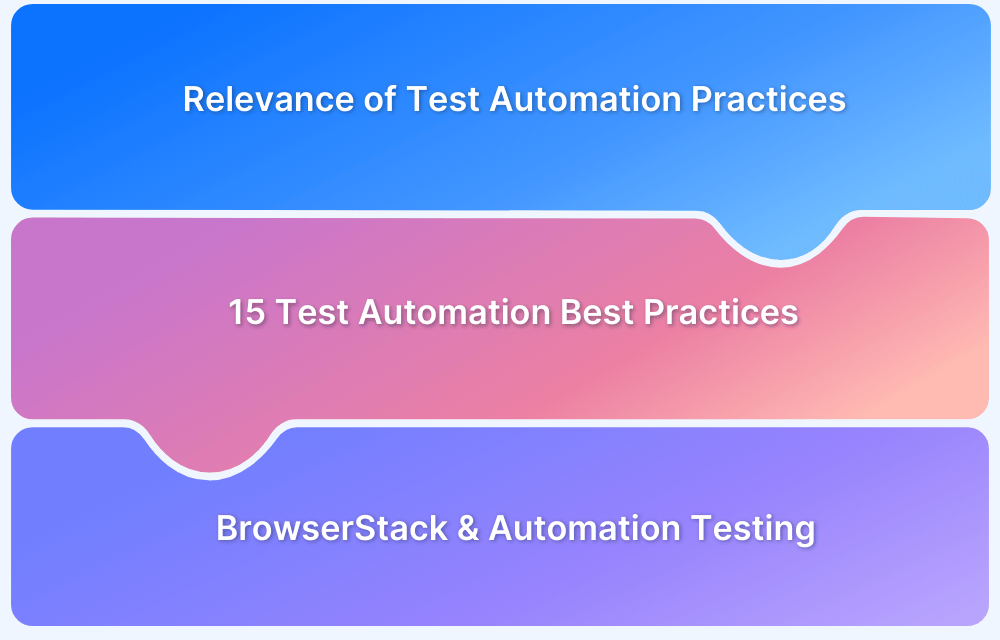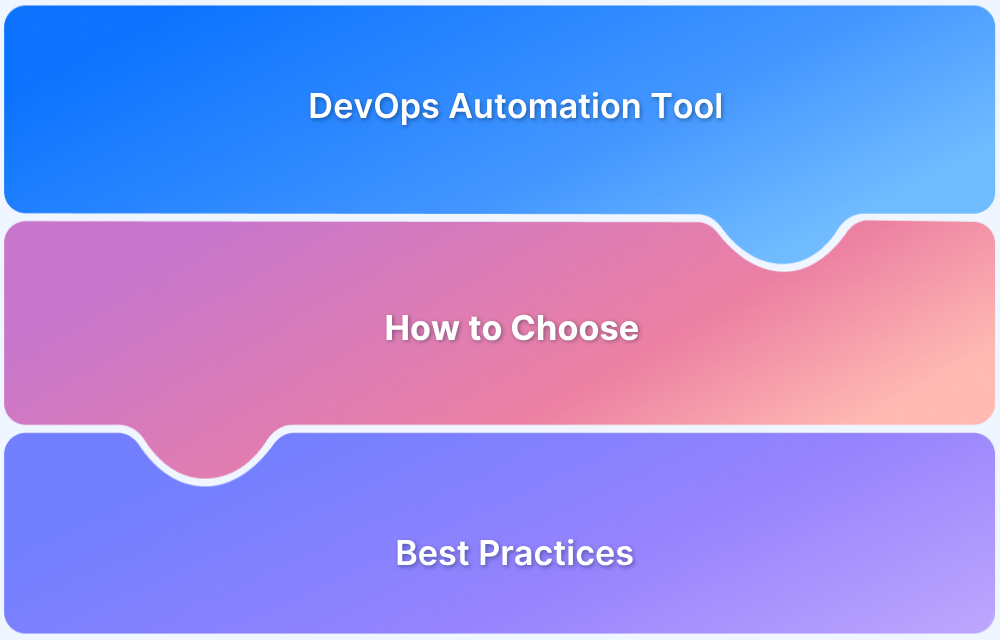Salesforce test automation is essential for maintaining the integrity of applications on the Salesforce platform. With regular updates and customizations, automating testing saves time and enhances accuracy, ensuring everything functions smoothly.
Overview
Salesforce testing ensures that customizations and integrations within the Salesforce platform function as intended without breaking core features. Test automation helps speed up the validation across frequent releases and complex workflows.
Salesforce Testing Tools:
Here are the popular automation tools to streamline and scale Salesforce testing:
- BrowserStack: It is an AI-native, cloud-based solution that offers seamless, no-setup automation testing for Salesforce applications across real browsers and devices.
- Selenium: Open-source automation framework widely used for web app testing, including Salesforce.
- Cypress: JavaScript-based testing framework ideal for fast, reliable UI testing of Salesforce components, especially in modern web setups.
- Leapwork: No-code automation platform with built-in support for Salesforce testing through visual workflows and reusable components.
- Provar: Test automation tool built specifically for Salesforce. It combines UI and API testing with deep integration into Salesforce metadata.
- Copado: DevOps and testing platform for Salesforce that supports automated testing within CI/CD pipelines.
- ACCELQ: AI-driven, no-code test automation tool with native Salesforce support and integration into CI/CD environments.
This article explores various tools available for Salesforce test automation, including BrowserStack, Selenium, Provar, and Cypress. Each of these tools offers unique strengths to help your teams.
What is Salesforce Test Automation?
Salesforce test automation involves using specialized tools to automatically validate the functionality, performance, and user experience of Salesforce applications. It ensures that updates and customizations don’t introduce bugs or break existing features.
Automating these tests saves time, reduces manual effort, and improves test coverage, allowing teams to focus on higher-value tasks.
BrowserStack Salesforce Test Automation enhances this process with AI-powered test creation, smart handling of dynamic elements, and reliable cloud execution on real devices, accelerating releases and improving overall quality.
What are Salesforce Automated Testing Tools?
Salesforce automated testing tools are platforms or frameworks designed to streamline the testing of Salesforce applications by automating repetitive test cases. These tools help verify that Salesforce customizations, workflows, and integrations function correctly after updates or deployments.
They support various types of testing, such as UI, API, regression, and cross-browser testing, and often integrate with CI/CD pipelines to enable faster, more reliable releases. Tools like BrowserStack, Provar, and Selenium are commonly used to ensure consistent performance and user experience across different environments.
Top 10 Test Automation Tools for Salesforce
Here are 10 top test automation tools that help ensure reliable and efficient testing of Salesforce applications:
1. BrowserStack
Salesforce automation testing is needed to increase testing efficiency, improve accuracy, and accelerate time-to-market of Salesforce apps. But it can be challenging without the right testing tools.
BrowserStack Salesforce Test Automation is an AI-native, cloud-based solution that offers seamless, no-setup automation testing for Salesforce applications across real browsers and devices.
Features:
- AI-powered test creation that converts natural language objectives into automated tests instantly.
- Metadata-aware locators for smart handling of dynamic elements like Shadow DOMs and iFrames.
- Reliable, no-setup execution on real desktop and mobile browsers in BrowserStack’s cloud.
- Parallel test runs to accelerate test execution and speed up release cycles.
Pros:
- Improves testing efficiency and accuracy while reducing manual effort.
- Expands test coverage across multiple browsers, devices, and OS combinations.
- Enables faster releases by accelerating test creation and execution.
Try BrowserStack Salesforce Test Automation
2. Selenium
Selenium is an open-source tool for automating web browsers. It allows you to simulate user interactions with Salesforce applications, for testing web-based functionality.
Features:
- It supports multiple languages (Java, Python, etc.).
- Browser compatibility with Chrome, Firefox, etc.
- Extensive community support
Pros:
- Free and open-source
- Highly customizable
- Large user community
Cons:
- Requires setting up your own infrastructure
- Can be slow for large, complex tests
- Steeper learning curve for beginners
3. Cypress
Cypress is a modern testing framework designed for fast, reliable testing of web applications. It works directly inside the browser, making it quick for debugging.
Features:
- Fast test execution
- Real-time browser interaction
- Easy debugging with video recordings
Pros:
- Fast and reliable
- Excellent for end-to-end testing
- Great developer tools
Cons:
- Limited browser support (Chrome, Electron, Firefox)
- Does not support multiple tabs or windows
4. Leapwork
Leapwork is a no-code automation testing platform, designed to make test automation accessible without coding knowledge. Used for Salesforce users who need quick automation without complex setup.
Features:
- No-code test automation
- Visual flowcharts for test cases
- Supports web, desktop, and mobile apps
Pros:
- Easy for non-developers
- Quick setup with visual workflows
- Scalable across teams
Cons:
- Limited integration options compared to code-based tools
- Can be expensive for smaller teams
Read More: 14 Best Codeless Automation Testing Tools
5. Provar
Provar is a Salesforce-specific test automation tool that allows users to easily automate functional and regression testing without writing code.
Features:
- Salesforce-native tool
- Supports end-to-end testing
- No-code test creation
Pros:
- Deep integration with Salesforce
- No-code interface for fast automation
- Quick to set up and scale
Cons:
- Limited support for non-Salesforce applications
- Can be pricey for smaller teams
6. Copado
Copado is a DevOps platform tailored for Salesforce, with features for automated testing, deployment, and monitoring.
Features:
- Salesforce-specific
- Supports continuous integration and delivery
- Automated test execution
Pros:
- Tailored for Salesforce environments
- Great for teams using DevOps practices
- Integrates easily with Salesforce orgs
Cons:
- Primarily focused on Salesforce, not suitable for general automation
- Can be complex to configure initially
7. ACCELQ
ACCELQ is a low-code test automation tool that offers AI-driven testing for Salesforce apps, designed to improve test creation and maintenance.
Features:
- Low-code test automation
- AI-powered test generation
- Integrates with CI/CD pipelines
Pros:
- Easy for non-technical users
- AI-driven for faster test creation
- Scalable for large teams
Cons:
- Not fully free
- Involves learning curve for advanced features
Read More: 25 Best DevOps Automation Tools
8. Tricentis Tosca
Tricentis Tosca is a comprehensive test automation tool known for its model-based approach, ideal for large enterprises, including Salesforce apps.
Features:
- Model-based test automation
- Supports continuous integration
- Integrates with various platforms
Pros:
- Powerful test modeling features
- Scalable for large organizations
- Integrates well with CI/CD
Cons:
- High cost
- Can be complex for smaller teams to implement
9. OpKey
OpKey is an intelligent test automation platform designed for cloud applications like Salesforce. It features AI and machine learning to optimize test execution.
Features:
- AI-powered test automation
- Cross-platform compatibility
- Supports SAP, Oracle, Salesforce, and more
Pros:
- Smart test execution with AI
- Quick setup for teams
- Supports a wide range of applications
Cons:
- Limited open-source support
- Complex setup for beginners
Read More: Top 12 AI Automation Testing Tools
10. Avo Assure
Avo Assure is a no-code test automation solution that supports end-to-end testing across multiple technologies, including Salesforce. It enables seamless automation without requiring programming expertise, making it accessible to all team members.
Features:
- 100% no-code test automation
- Supports over 200 technologies, including Salesforce
- End-to-end testing for UI, API, and database
- Parallel execution for faster testing
Pros:
- User-friendly, no coding required
- Broad technology compatibility
- Scalable for large enterprise needs
Cons:
- May have a steeper learning curve for advanced customization
- Limited pre-built templates for specific Salesforce workflows
Why is Salesforce Test Automation important?
Salesforce test automation is important because it improves the efficiency and reliability of testing, ensuring applications work properly after updates and new features.
By automating tests, you and your teams can quickly spot and fix bugs, reduce manual effort, and maintain consistent quality. This leads to faster deployment cycles and a better overall user experience.
Below are some key pointers to help you understand the importance of Salesforce automation tool:
- Efficiency: Saves time and manual effort in testing.
- Reliability: Minimizes human error for greater accuracy.
- Faster Feedback: Quickly identifies and resolves issues.
- Consistency: Provides uniform testing across various environments.
- Improved Quality: Boosts application performance and user satisfaction.
Types of Salesforce Testing
Salesforce testing includes different methods to make sure applications work well and meet user needs. Each type of testing looks at specific parts of the application, helping teams find and fix problems during development. Below is a list of types of salesforce testing.
- Unit Testing: Verifies each component to ensure it functions properly.
- Integration Testing: Tests how different systems or components interact with each other.
- Functional Testing: Verifies that the application meets specific requirements and performs as expected.
- UI Testing: Makes sure the user interface is easy to use and looks good.
- Performance Testing: Evaluate the application’s speed and stability under various loads.
- Regression Testing: Confirms that new changes haven’t disrupted existing functionality.
These testing types are essential for delivering high-quality Salesforce applications.
Salesforce Automated Testing with Selenium
Selenium is a powerful tool for automating web applications, including Salesforce. It allows for testing UI interactions, validating workflows, and ensuring overall functionality.
Prerequisites:
- Selenium WebDriver: Make sure you have the most recent version set up.
- Java/Python: Use a programming language supported by Selenium.
- Salesforce Credentials: Access to a Salesforce instance for testing.
- WebDriver for Browser: ChromeDriver, GeckoDriver, etc.
Setup:
Step 1. Install Selenium:
- For Python:
pip install selenium
- For Java: Add Maven dependency.
Step 2. Configure WebDriver: python:
from selenium import webdriver from selenium.webdriver.chrome.service import Service from webdriver_manager.chrome import ChromeDriverManager # Configure WebDriver (automatically installs the correct chromedriver version) service = Service(ChromeDriverManager().install()) # Automatically installs chromedriver driver = webdriver.Chrome(service=service)
Step 3. Login to Salesforce:python:
driver.get("https://login.salesforce.com")
from selenium.webdriver.common.by import By
# Open Salesforce login page
driver.get("https://login.salesforce.com")
# Enter username and password, then click the login button
driver.find_element(By.ID, "username").send_keys("your_username")
driver.find_element(By.ID, "password").send_keys("your_password")
driver.find_element(By.ID, "Login").click()Writing Tests:
Step 1. Locators: Use XPath or CSS selectors to find elements.
element = driver.find_element_by_xpath("//input[@name='search']")Step 2. Assertions: Validate expected outcomes.
assert "Home" in driver.title
Step 3. Test Example:
def test_create_lead():
driver.get("https://yourInstance.salesforce.com/lead/new")
driver.find_element(By.ID, "name").send_keys("Test Lead")
driver.find_element(By.ID, "save").click()
assert "Lead created" in driver.page_sourceBest Practices:
- Use Page Object Model (POM) to organize your code for better test maintainability.
- Explicit Waits: Implement waits for elements to load:
from selenium.webdriver.common.by import By from selenium.webdriver.support.ui import WebDriverWait from selenium.webdriver.support import expected_conditions as EC WebDriverWait(driver, 10).until(EC.visibility_of_element_located((By.ID, "element_id")))
- Data-Driven Testing: Use external files for test data.
Selenium is an effective tool for automating Salesforce testing, ensuring efficient validation of UI components and business logic. Always maintain your tests and adapt to Salesforce updates.
How to choose the best Salesforce Automated Testing Tool?
It can be tricky to pick the right tool in this competitive market, but this article will guide you in finding the best option for your needs.
For a reliable and efficient Salesforce automated testing experience, consider tools like BrowserStack that excel in compatibility, ease of use, and comprehensive testing features.
- Compatibility: Ensure the tool integrates seamlessly with Salesforce.
- Ease of Use: Look for a user-friendly interface that requires minimal setup.
- Cross-Browser Testing: Verify that the tool supports multiple browsers and devices.
- Scalability: Choose a tool that can handle large test suites and scale to meet your needs.
- Real Device Testing: Ensure the tool provides access to real devices for accurate results.
- Integration Capabilities: Check for compatibility with CI/CD tools for streamlined workflows.
- Support and Community: Look for tools with robust customer support and an active community.
Key Challenges in Salesforce Test Automation
Automating tests in Salesforce can be rewarding, but it comes with its own set of challenges. Here are some of the key obstacles you might face while automating Salesforce test scripts:
- Dynamic UI Elements: Salesforce often has elements that change frequently, making it hard to create stable test scripts. To address this, strategies like explicit waits, relative locators, or robust XPath/CSS selectors can help ensure the reliability of your tests.
- Complex User Interfaces: Salesforce’s intricate design can complicate how you identify and interact with different elements, leading to more complex automation scripts.
- Frequent Updates: Salesforce regularly updates its platform, which can break existing tests and require constant maintenance to keep everything running smoothly.
- Data Management: Ensuring your test data is consistent and relevant is crucial, but it can be challenging to maintain.
- Integration Testing: Testing how Salesforce works with other apps and third-party tools can add complexity, as you need to ensure everything functions seamlessly.
- Performance Issues: Automated tests may slow down with large data sets or complex workflows, so optimizing performance is key.
- Cross-Browser Compatibility: Making sure your tests work well across different browsers can be tricky, especially with dynamic content involved.
Read More: How to test UI Components
Best Practices for Salesforce Test Automation
Salesforce test automation helps keep your apps running smoothly and ensures they work correctly. It’s important to follow key practices to get the best results, like using stable test scripts, managing data well, and keeping tests updated.
Below are some best practices to help you optimize your Salesforce test automation efforts.
- Stable Element Locators: Use unique and reliable locators (like custom IDs) to avoid test failures from UI changes.
- Use Salesforce APIs: Automate data setup and verification through Salesforce APIs instead of UI for faster and more reliable tests.
- Modular Scripts: Break tests into smaller, reusable parts for easier maintenance and scalability.
- Focus on Key Flows: Automate the most important business processes to get the most value from your tests.
- Handle Dynamic Data: Use waits and dynamic locators to manage elements that change or load unpredictably.
- Test Data Consistency: Ensure you use test-specific data to avoid interference with live data.
- Parallel Testing: Run tests in parallel to speed up execution, especially with large datasets.
- Keep Tests Updated: Regularly update tests to align with Salesforce platform updates and changes.
- Cross-Browser Testing: Ensure your tests work across multiple browsers, especially for dynamic content.
- CI/CD Integration: Set up Continuous Integration/Continuous Deployment to run tests automatically and catch issues early.
Benefits of Performing Cross-Platform Testing for a Salesforce Application
Cross-platform testing ensures your Salesforce app works flawlessly on different browsers and devices, providing a consistent user experience. Key benefits include:
- Broader Compatibility: Test across various browsers (Chrome, Firefox, Safari, etc.) and OS platforms (Windows, macOS, iOS, Android) to catch compatibility issues early.
- Real-World Accuracy: Use real devices for testing, ensuring more reliable results than simulators.
- Faster Bug Tracking: Quickly identify and fix compatibility problems, improving app performance.
- Efficiency: Automate tests across multiple platforms at once, saving time and resources.
With BrowserStack Automate, you can run tests on real devices in the cloud, ensuring smooth Salesforce functionality across all platforms. BrowserStack’s cloud-based solution offers easy scalability, enabling you to run multiple tests simultaneously and speed up the testing process.
By using BrowserStack, you eliminate the need for manual testing on different devices. You can also access detailed logs, screenshots, and videos for each test session, making it easier to debug issues and improve test accuracy.
Why Choose BrowserStack for Salesforce Test Automation
Accelerating Salesforce app delivery requires efficient, accurate, and scalable testing, something manual testing alone can’t achieve.
BrowserStack Salesforce Test Automation is an AI-driven, cloud-based solution that enables effortless, zero-setup automated testing for Salesforce applications on real browsers and devices. Powered by AI, it simplifies test creation, execution, and debugging to deliver consistent performance across all environments.
Why Choose BrowserStack for Salesforce Test Automation
- AI-powered test creation: Describe your testing goal, and AI instantly generates the test scripts.
- Smart test authoring: Easily manage dynamic elements using metadata-aware locators.
- Reliable execution: Run tests on real cloud devices for stable, flake-free results.
Boost release speed and test coverage for your Salesforce applications, while focusing on strategic priorities, with BrowserStack Salesforce Test Automation.
Conclusion
Salesforce test automation is vital for improving testing efficiency, accuracy, and accelerating the release of high-quality Salesforce applications. While various tools exist to support automation, choosing a solution that combines ease of use, compatibility, and scalability is key to overcoming challenges related to dynamic UI elements and frequent updates.
BrowserStack Salesforce Test Automation stands out by offering an AI-native, cloud-based platform that enables seamless test creation, smart handling of complex elements, and reliable execution on real browsers and devices. This empowers teams to enhance test coverage, reduce flakiness, and speed up delivery, ensuring a consistent and superior user experience for Salesforce applications.






